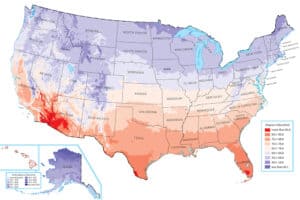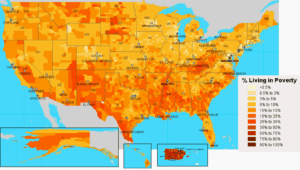Summer is heating up across the United States, hitting record highs and preparing for extreme weather events.

GIS Geography, Last Updated: July 25, 2022
Over 100M Americans were under severe weather warnings this past weekend. Our air conditioners have been constantly running, sometimes to keep us sane, sometimes to keep us alive, so we were interested in how other Americans are using this life-saving appliance. In our recent study, we uncovered some hard truths.

In a study by the U.S. Energy Information Administration, we learned that over 1 in 5 households do not have access to any air conditioning equipment, including central air, ductless heat pumps, window or wall air conditioning units, portable air conditioners, or evaporative coolers.
There are some homes that do not have air conditioning because they elect not to. However, our projections show that that number would be closer to 3-7% in higher-income populations.
Installing and maintaining an air conditioning unit in this country is expensive. The US is unique because central air is a common technology. Japan actually outpaces the US in households with air conditioning, but they use per-room units [3]. Central air and duct air conditioning are notably more expensive.
The average cost of installing an air conditioning unit in the US can cost up to $7,000 [4]. The average cost of cooling a home in Arizona, the most expensive state in the US, is $477 [5]. This is quite a steep expense in a nation where 21% of households have $4,999 or less in savings [6].
Households making $20k or less are four times more likely to have air conditioning serving multiple units; this lack of control over there can make updates and retrofit outprice affordable housing.
Inequity based on income level is nothing unique to the HVAC industry, but it does offer opportunities that do not exist in health or education reform in that we might be able to do something about it.
As temperatures rise, air conditioning is becoming more than just about the quality of life, it is becoming a lifesaver. About 600 heat-related deaths occur every year in the US [7]. Heat waves are at an all-time high. Heat-related illnesses are climbing in lockstep. Heat-related deaths occur most frequently in urban areas (81%), and the three states with the highest burdens, Arizona, Texas, and California, accounted for 43% of all heat-related deaths.
Air conditioning is one of the only preventative measures we have to save people from extreme temperatures. Cooling centers are interventions necessary in places like Houston, where they serve as open-air conditioning havens for those who do not have access to it during triple-digit temperature weekends [8].
Access to air conditioning is not equal. Almost 1 in 10 U.S. citizens are making $15k a year or less, according to the 2020 US Census [9].

When you see these maps together, the gravity of the situation starts to set in. Low-income Americans are mostly in the country’s hotter states. As it gets hotter, this injustice does lead and will continue to lead to more heat-related illnesses and deaths.
Once again, the US’ ever-increasing wealth gap is eroding the bodily security of the nation’s most vulnerable. Temperatures are rising, poverty is rising, and our rights and social safety net are shrinking. The recent overturning of Roe v. Wade only exacerbates this problem by directly impacting an individual’s poverty level.
Free air conditioning programs have cropped up in communities where there is a major need. The Low Income Home Energy Assistance Program (LIHEAP) is the United States' program that gives grants to families to help pay their home energy bills. U.S. Department of Health & Human Services Secretary Xavier Becerra, HHS announced $385 million in awards to support local LIHEAP on April 21, 2022, bringing the total available funding to $8.3 billion, making 2022 the largest single year since LIHEAP’s establishment in 1981 [11].
HHS, LIHEAP, and the Biden-Harris administration are making the investment to ‘ensure safe and healthy indoor temperatures’ and “comes at an important time as households across the country continue to struggle with higher energy bills," said ACF Assistant Secretary January Contreras.

“LIHEAP provides a vital lifeline to households struggling to maintain continuous, safe, and affordable home energy services." As the nation grapples with the impacts of climate change and the threat of extreme weather, which disproportionately impact communities of color and lower-income households, LIHEAP is a critical tool to promote both energy justice and racial equity.
So, we’re talking about adding $8.3 billion of government funding to increase access to air conditioning, as well as heat to note, but we will follow up with a study on heating access across the US in warmer months. We are advocating for 2.5 million households to gain access to HVAC systems. How will this impact climate change?
The main drawback to air conditioning is that it consumes a lot of energy. Air conditioners and electric fans account for nearly 20% of total electricity consumed worldwide [12]. Rising demand Space cooling is straining power grids. Global projections suggest that energy demand from air conditioners will more than triple by 2050.
Our main task is to improve the efficiency of air conditioners. Energy-efficient labeling programs have proven to improve consumer awareness and education; see the ENERGY STAR program [13]. The Minimum Energy Performance Standards (MEPS) on AC is another expanding program in the US.
The current administration is prioritizing weatherization and clean energy with its massive influx of infrastructure spending directed toward this issue in particular. We will be following the allocation of this money very closely.
If you’re looking to access cooling assistance, you can visit their local websites to get support [14]. The top 5 state recipients of federal LIHEAP funding are listed below.
If you’re looking to access clean energy sources, there are a number of programs that provide subsidies and support to reduce your household’s carbon footprint. Solar Tax Credits, Net Metering, Property Tax Exemptions, and Sales Tax Exemptions are methods to access government-sponsored savings while improving your energy efficiency [15]. The top states for solar energy tax incentives are:
Local, state, national, and global governments are working on improving the efficiency of air conditioners while increasing access to AC units, which increasingly being viewed as a key pillar in quality of life and human development.
Click to View the Data SET:
Air conditioning in U.S. homes, by household income, 2020

Copyright © Techcool 2021. All Rights Reserved | Privacy Policy | Terms | Sitemap